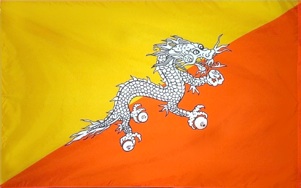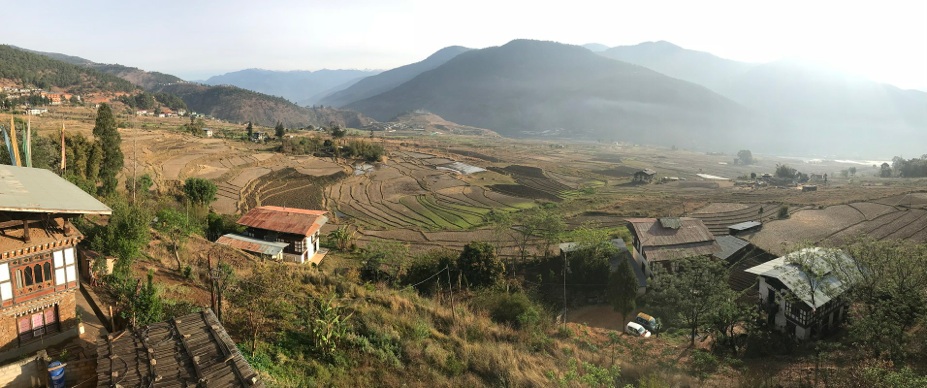Balkans 2016
Balkans 2016 Albania Kosovo Macedonia

Bhutan
2018
We awoke this morning to the beautiful, sweet sound of bird songs right outside our window. As our hotel was built in a cascading style down the side of the escarpment overlooking the Mo Chhu valley, the tops of the trees below us were right at the level of our window, so the sounds of the birds could not be missed.
It was as though they were telling us to wake up so as not to miss the spectacular view across the valley in the early morning light. And the view was indeed spectacular from every vantage point in the hotel – our window, the balcony above, and the restaurant window from which the panoramic photo at the bottom of today’s page shows.
We had two main tasks to complete today. First, we were to travel from Punakha to Thimphu, a distance of 71 kilometres with an estimated driving time of two and a half hours. Clearly, that drive would not take the whole day, which led to the second task – completing not one but two hikes.
After a wonderful breakfast, which was as enjoyable for the early morning views as it was for the food, we set off at 7:30am from Lobesa north through Punakha to the end of the road in the Mo Chuu Valley, a 45 minute drive. Parking the car, we began our hike by crossing a suspension bridge over the Mo Chuu before following a track through the padi fields, vegetable gardens and hillside terraces to the top of the hill, a climb that took a little less than an hour to go from an altitude of 1,250 metres (at the suspension bridge) to 1,450 metres (at the summit).
One of the stops we made on the climb was at a large prayer wheel on a ledge that overlooked the valley below. An old man was turning the prayer wheel, which made a ringing sound each time it completed a revolution. The periodic ringing of the bell reverberating across the wide valley was the only sound to be heard in the stillness of the morning – a magic experience.
The fields looked magnificent in the morning light, and a substantial number of farmers were already hard at work in the fields. In Bhutan, farmers never work on their own, but receive help from their neighbours whenever planting, weeding, harvesting, and so on needs to be done. When their neighbours do some work, they will reciprocate by going to help. In this way, community bonds between farmers are very strong, and they become more so over time through this system of reciprocity.
Our destination at the summit of the hill was the beautiful Khamsum Yuelley Namgyal Lhakhang (temple). The temple was built under the authority of the Queen Mother Ashi Tshering Yangdon Wangchuk to honour her son, the King, and to bring peace and stability in an ever-changing world. The grounds were very serene and ordered if unspectacular, but the interior was something else again. This part of Bhutan follows a tantric tradition within Mahayana Buddhism, which involves an extraordinarily complex theology of saints, demons, bodhisattvas, reincarnated beings that take on different forms, benign and evil spirits, and so on, many of which engage in some fairly frightening activities.
This was amply illustrated as soon as I walked into the interior of the temple, as a huge display (perhaps 10 metres in height) showed in gruesome detail the interplay between these various divine players. The temple comprised three storeys, and the upper two storeys were comparatively more benign. The real joy of climbing upwards through the temple’s interior was reaching an open rooftop 4th storey from which exquisite panoramic views of the surrounding countryside could be seen – intensive farming activities, long terraced hillsides, the winding Mo Chuu river valley, the snow-capped peaks of the Himalayas – it was all there and the elevated view was like floating above the crystal clear landscape. Simply stunning in its beauty!
On the walk downhill, we passed something like a hundred other visitors who were ascending the same trail. Given our gloriously serene experience both on the upward climb and at the temple itself, we were very grateful indeed that we had made such an early start to the day.
Returning to our car was not an easy experience. When we parked our car in the small dirt field by the suspension bridge, ours was the only car present. By the time we returned, there were tens of cars and minibuses, which accounted for the constant stream of people we had passed on the trail during our descent, as well as the eager groups of people gathering under the suspension bridge to go rafting down the Mo Chuu to Punakha.
Once in the car, we began the two-hour drive through Punakha, Walakha, Sopsokha and Lobesa to Dochula, the mountain pass we had visited briefly the previous day. Upon reaching Dochula at 12:15pm, we immediately visited the Druk Wangyal Lhakhang (monastery) that overlooked the 108 chortens we had visited the previous day. Like the chortens, the monastery was built under the authority of the Queen Mother Ashi Dorji Wangmo Wangchuk as a tribute to her son, the fourth king of Bhutan, Jingme Singye Wangchuk, who personally led Bhutanese soldiers into battle to suppress an armed insurrection by Assamese Indians in the south of the country in 2003.
Five murals inside the monastery showed each Bhutanese king, while a sixth mural showed the fourth king in military uniform bravely leading the soldiers to put down the separatist insurrection. It was a particularly interesting mural as it used traditional Bhutanese art forms to show the king battling the militants in the jungle, with monks using a laptop computer and a Drukair airliner in the sky – quite an unusual mural even for a Bhutanese monastery.
After a buffet lunch of questionable quality in the cafeteria located at Dochula pass, we embarked on our second (and longer) hike for the day. This hike took us from 3,100 metre altitude at Dochula to 3,566 metres at Lungchu Tsey monastery (also known as Lungchutse Goemba) along a track that was labelled as a 7 kilometre return trip that would take two hours each way.
In fact, we took an hour and a half to ascend and one hour ten minutes to descend. It was a wonderful (if at times steep) walk through bright red rhododendron groves and woods covered in moss (apparently an indicator of clean, moist air), with views of the snow-capped Himalayas through the trees for parts of the walk. It had everything you could want in a mountain hike except perhaps sufficient oxygen.
We reached the monastery and the summit of the hill at a little before 3:00pm. The clear skies gave great views over the valleys and surrounding mountains. We stayed for about half an hour before starting our descent, during which time the skies darkened with thick grey clouds, and we completed the last part of our descent in light rain and cold wind as we reached Dochula.
After a coffee to warm us up again, we began the final leg of the day’s travels, the one hour drive into Thimphu, Bhutan’s capital. We reached our hotel, the Namgay Heritage Hotel at a little before 6:00pm. We felt justified in feeling ready for a good dinner and rest – to quote the statistics for the day from my phone, we had walked 16.3 kilometres, completing 27,300 steps, and climbed the equivalent of 197 floors.
Not a bad day’s effort.

Day 5 - Punakha to Thimphu
Monday 2 April 2018
















